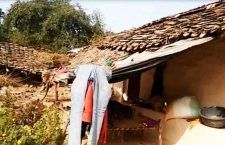“We buy most of the medicines from private pharmacies, they don’t give us most of them,” said Chunni Lal, a Jabrapur resident who had travelled to the Naveen Primary Health Centre in Fatehganj, Banda. He came to the PHC to ask a doctor for a treatment for the marks that had started to spread from his back and arms to his face, and had to leave only with a prescription and a request asking him to buy the necessary medication from the market.
Primary Health Centres or PHCs are supposed to to be well-equipped to deal with in- and out-patient care, with an ambulance service, functional operational theatre and labour room as the first points of contact for medical care in rural India, as devised by the National Health Mission. The Indian Public Health Standards for PHCs clearly states that all the drugs required for the National health programmes and emergency management should be available in adequate quantities so as to ensure completion of treatment by all patients. The understocked Naveen PHC is only one of many centres in the country failing to meet this basic requirement.
UP, the most populous state in the country, has only 3621 functioning PHCs—which is a shortfall of 30% because the requirement in the state is of 5194 PHCs. And these existing PHCs, too few they may be, are providing inadequate services. A report from the Planning Commission found that 66.67% of all PHC beneficiaries expressed dissatisfaction with the non-availability of medicines.
“Apart from a handful of medications, we currently have everything stocked in our pharmacy—cetzine, paracetamol, antibiotics,” swore Premchand, the pharmacist at the PHC. But Anarkali visited the same centre for a fever, cold and cough–illnesses often treated with the same medicine compounds he listed–and was asked to buy medicines from outside.
Arpita, from the village of Jarkadha, had the same problem: “I bought the syrup for Rs.200 from the pharmacy outside the hospital.” Rs. 200 on one round of one medication is no small expense, especially not for state with 30% of its population living below the poverty line. Research has shown that 4.49% of all total consumption expenditure was spent on out-of-pocket (OOP) medicines, significantly on the uptick in the last few decades– making it the largest component of the total OOP payments by households. In fact, 38 million Indians were driven into poverty because of OOP medicines in 2011-2012.
“They are no providing us with required medicines that are being provided in every other hospital,” said another Jarkadha resident Bhagwati, her frustration palpable– rightfully so, as this is a service that the government is supposed to provide.
But according to an Indiaspend study, India spent the least on public health among all the BRICS nations in 2017; it ranked 147 among 148 countries in this regard, and according to the same study, only 31.3% of the total healthcare expenditure in 2014 was done by the government. Meanwhile, the budget allocation for National Health Mission has seen a 2.1% decline from Rs 31,292 crores in 2017-18 (revised estimates) to Rs 30,634 crores in 2018-2019 (budget estimates).
“Because they don’t give us proper service we are forced to visit private hospitals for decent check ups,” added Bhagwati. OOP medical expenditure– including paying for private hospitals–pushed 50.6 million people into poverty between 2004 and 2014– of which 27% lived in UP.
The widely-publicised Prime Minister’s Ayushman Bharat Yojana, launched in September, is supposed to be the solution to all rural healthcare woes. It’s most flashy promise is the health protection of a cover of Rs. 5 lakhs per poor family per year. But research has shown that insurance-based government initiatives have been largely unsuccessful in easing the burden on citizens. How can an insurance scheme help if the service provisions themselves are sorely lacking?
“Medicines for allergies and many other illnesses are still not available,” said Premchand, after some persistent nudging from our reporter. He added, “But we are assuring our patients that all of these medicines would be made available by the end of December”, as informed by the department in-charge. And as for the protocol of prescribing and giving medicines he said: “If the medicines aren’t available, we tell the patients to come back again in fifteen days. And if they’re unavailable then as well, we ask them to either go to the district hospital or to buy it from outside.”
But healthcare isn’t a leisurely activity; it is often a matter of some urgency. When asked what they do if medicines are required immediately, Premchand had no answer.
When our reporter asked Bhagwati if she had ever complained about the services or lack thereof in Naveen PHC, she replied with a sense of resignation, “Who listens to poor people?”
This Khabar Lahariya article first appeared on Firstpost

